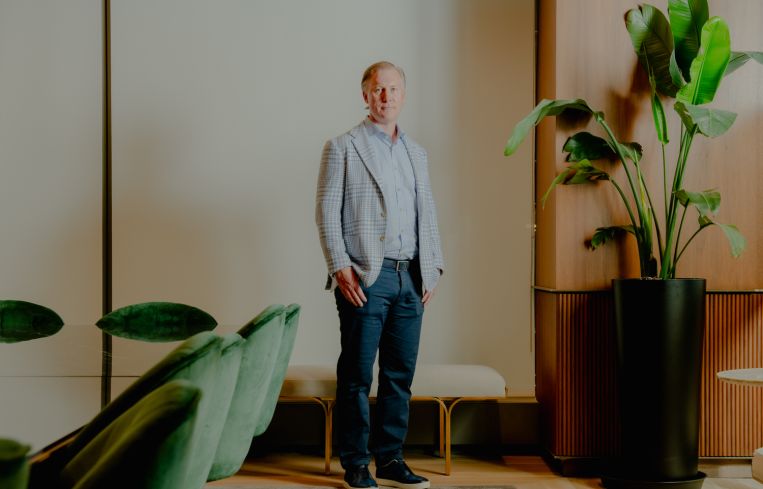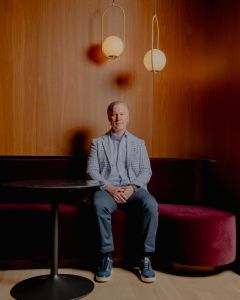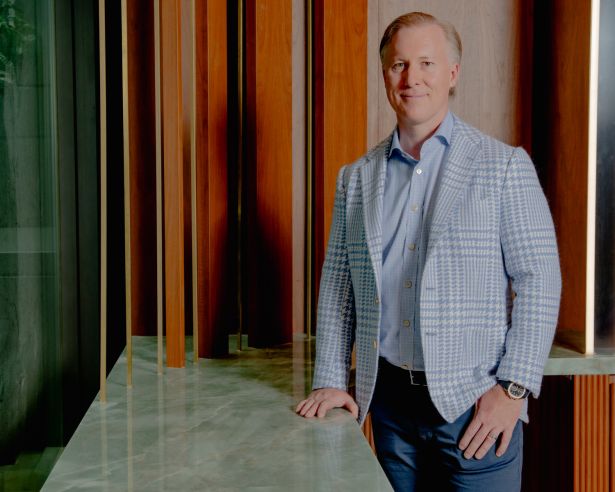How Landmark’s Wes Rogers Became America’s Largest Student Housing Developer
‘There’s less focus on partying, and more focus on wellness and studying.’
By Brian Pascus September 2, 2024 10:00 am
reprints
Wes Rogers has come a long way in 20 years.
He started his real estate business in 2004 with virtually no capital, a graduate school business plan, and only the haziest idea of targeting commercial real estate investment in recession-resistant asset classes like medical office space and student housing.
Fast forward to 2024: With $14 billion in assets, 72,000 student beds under management, and more than 115 student housing communities, his Landmark Properties is setting the pace in an increasingly growing asset class. Last year, Landmark delivered 10 new student housing communities and approximately 8,195 beds — a $2 billion portfolio that accounted for 25 percent of all U.S. student housing deliveries in the 2023 school year alone.
Commercial Observer sat down with Rogers, Landmark’s co-founder and CEO, to learn how he became the undisputed king of student housing.
The conversation has been edited for length and clarity.
Commercial Observer: Talk to me about Landmark — what’s the history behind it?
Wes Rogers: We started Landmark 20 years ago, in May 2004, literally the day I graduated from business school at the University of Georgia. We started the company with the idea of creating a small real estate development firm focused on housing near universities.
Medical offices was the original thesis, actually. Originally, we did a student housing deal and a medical office deal, which took forever to stabilize — the doctors were tough to negotiate with — and while we made some money on it, the whole thing took forever. But the student housing deal really took off, so we’ve largely been focused on student housing for the last 20 years. And for the last four or five years we’ve expanded into single-family rental, build-to-rent and traditional multifamily.
How is Landmark structured?
We’re vertically integrated, so we’re the developer, owner, general contractor, investment manager and property manager. We do have investors in our deals, typically, but we’re usually the sole general partner in the deals that we do. Having our in-house general contracting entity has been a huge competitive advantage for us, particularly in a business like student housing, where delivering on time and on budget is super important, as the school year starts whenever the calendar starts, and they don’t care if your construction is complete or not.
It’s paramount in our business to deliver on time and on budget, and being able to control the construction process has been a huge competitive advantage, as it allows us to rein in costs more.

Landmark delivered $2 billion in new properties during the 2023 school year. How did that happen amid a high interest rate environment?
Student housing demand is much steadier than other CRE asset classes. It’s kind of an oligopoly, where there’s only a few groups doing the vast majority of the work for myriad reasons: It’s more operationally intensive than conventional multifamily, with unique operating characteristics and unique risks, and there’s only a small handful of groups who can develop to scale.
So you’ve seen supply has been relatively moderate in student housing, whereas in the conventional multifamily space, you’ve seen a record amount of units being delivered and the excess supply is weighing on rents. Student housing is different, whereas that supply and demand is much more imbalanced: You’re seeing enrollments grow, there are 65,000 students per year in the universities we target at the top 200 schools, but you’re seeing off-campus new supply in the range of 45,000 beds per year.
Because of that, you’re seeing good rent growth. We’re in year three of 10 percent annualized year-over-year rent growth, and so that rent growth is unlike other real estate classes, and it allows us to develop opportunities because the numbers pencil for us.
What is the financing process like on these deals?
From an investor standpoint and from a lender standpoint, we never really push leverage very high. We tend to use modest leverage, but we have a great group of banks, and they continue to offer us capital. We have our own balance sheet also, where we invest pretty heavily in our deals.
And we have a great group of investment partners, who we’ve worked for years and years, and have built a good reputation for doing what we say we’ll do, and we’ve built a lot of trust with investors. So, even though there’s not as much capital to go around, they still view us as a good risk-adjusted return and a safe place to park their money.
Who are some of these investment partners?
We have a partnership with the Abu Dhabi Investment Authority; they’ve been our largest partner over the last decade. John Hancock, Manulife and Blackstone have been big partners. Our partnerships range from the biggest institutions, sovereign wealth funds and private equity firms to smaller private equity firms, and, even more recently, family offices, who tend to be smaller in check size but more nimble in their investing activities.
What makes Landmark’s student housing properties different from the competition?
We really focus on the needs of today’s college students and try to provide a real service-oriented brand to them. We’re typically catering to the higher-end student, and therefore try to create as much value in our buildings as possible, but we try to cater to students who want to live close to campus, in a highly amenitized building, and still be within walking distance of campus and the nightlife and Greek housing. So our buildings tend to be a bit bigger, a bit more heavily amenitized with nicer finishes than what you might see in the competing buildings.
Was it difficult to finance student housing into more of a luxury product before the student housing boom kicked off?
Well, yeah, I’ve spent so much of my career talking to capital, trying to raise money. That’s a big part of my job and has been for 20 years. There certainly were times when it was difficult, there weren’t many investors in the business, but you fast forward to today and the largest investors in the world are investing in student housing. That includes Blackstone, Abu Dhabi Investment Authority, CPPIB [CPP Investment Board of New York], GIC [a Singapore investment fund], APG [a Dutch pension investment company] — the largest investors in the world have significant investments in this sector.
How do students pay your rents when it’s not subsidized by the school?
It’s all over the board. We try to deliver a product that can be available at multiple price points. Affordability is a huge issue in housing in general, and certainly in student housing. Some of our students are on financial aid, some have jobs, some don’t, some have parents who pay the bill, so it’s myriad backgrounds for our residents. We try to cater to that and have multiple price points. We’ll have studio, one-bedroom, four-bedroom, sometimes six-bedroom units. Those six-
bedroom units might be a little smaller and share a bathroom, but that allows us to drive the price point down.
What’s the biggest risk in developing student housing?
The biggest risk of student housing development is delivering projects on time and on budget. You’re typically starting construction two to three years before the project is delivered, and you want the project to be delivered just before the start of school. Students pre-lease the building so they can move in in late August, regardless of whether the building is completed or not. So you have to be done by the time they’re ready to move in for school — otherwise it’s costly from a financial and reputational standpoint. Then you’re delivering late and costing students thousands of dollars per night, or terminating their leases and being left with a vacant building all year.
It’s a risk that’s unique to student housing. In conventional multifamily, if you’re late it’s no big deal, you move residents in later. But you can’t be late with student housing because students start school and need a place to live.
How has student housing changed over the last 10 to 20 years?
When we first started doing it, we were building properties farther from campus, probably lower-cost, but we saw students really wanted to be closer to campus. They wanted to have a parking space for their car, or they wanted to walk to classrooms, walk to nightlife, really live a pedestrian lifestyle, and they also wanted to have the amenities, the study areas, the fitness centers, the swimming pools, areas to interact with friends and meet new people.
So providing living environments to them that are close to where they want to be and in the units they desire with lots of safety and security, we saw demand in that. But the product has evolved from farther from campus — like, two-story walk-ups — into more mid-rise and high-rise buildings that are heavily amenitized.
What was the old student housing business model pre-21st century?
Forty to 50 years ago, there was some housing off campus, but most kids lived in a shadow rental market; that is, housing not purpose-built for students: townhomes, traditional apartments, small homes, rental houses. So what you saw in these college towns is towns would enact ordinances in the 1990s and 2000s to push students out of single-family neighborhoods.
In Athens, [Ga.], our hometown, that city passed an ordinance that said no more than two unrelated people could live in a single-
family-zoned neighborhood. That prevented four to five kids from living together in a house. It made it unaffordable to rent a house and pushed students out of neighborhoods. All of a sudden, there was a stock of housing that students couldn’t live in, and we provided purpose-built housing for them just as they were being pushed out of the neighborhoods. We were providing highly amenitized housing, close to campus, geared toward their lifestyles, and where they could live with their peers.
How do you see the asset class evolving during the 2020s?
If there are 7,000 colleges and universities in America, we’re typically focused on 200 markets that are generally publicly chartered state institutions with enrollments of 15,000 or more and select private universities with significant off-campus demand. At those universities, you’ve seen applications increase and selectivity increase as the acceptance rate has gone down, so there is more of a focus on academics at those universities.
Because of that, in order to get deals to pencil, projects have been designed more efficiently, and that’s brought down the size of units and there’s more shared space in buildings. So we see more efficiencies, less elaborately designed amenity spaces like those huge swimming pools. Amenity areas are shrinking and becoming more efficient, so there’s less focus on partying, and more focus on wellness and studying. Those projects that will be available in the mid- to late 2020s are already designed or are being designed.
How will Landmark benefit from this shift?
Most peers and competitors have short-term capital that is a three- to five-year focus, whereas our capital is 10-year focused and it enables us to take on a long-term perspective. We’re not having to sacrifice the quality of the short-term product just to get deals capitalized. While we are trying to be more efficient, we haven’t jumped on this high concentration of double-occupant and super-tight units.
Where we’ve been more efficient is with our amenity space, as some of them they’re not getting utilized as much as we’d like them to, so we’re cutting that and focusing on wellness and we’re being very careful with how we do it and we’re not sacrificing space in markets where we don’t think it can be sustained.

What is your history in CRE? How did you fall in love with the business?
My dad was a small developer, so I grew up around commercial real estate and it always interested me. As an undergrad, I always had a head for numbers. I worked in finance as a bank analyst my first year after undergraduate, but I didn’t like banking or corporate America, so I wanted to do something entrepreneurial, and I was dabbling in real estate on the side, investing in rental properties, flipping houses and whatnot.
So the idea of development, of building, excited me, but I didn’t have any money or experience, so I didn’t know how to get into the business, and when I went back to business school, I wrote a business plan for what became Landmark.
What type of impact did your father’s career in real estate have on you?
My dad was a small developer, and, candidly, what I learned from him is that commercial real estate can be a very risky business. He had some boom and bust times — I felt that in my childhood — and that gave me a conservative nature and a real focus on risk mitigation and downside protection, which are skills that I feel have been helpful for me as I built businesses in a somewhat historically risky industry.
James B. Whitley is your co-founder and chief operating officer. What’s that partnership like?
I’ve known James for a long time. We became friends late in college and just after college, and it’s been a great partnership, obviously. Partnerships are kinda like a marriage and we’ve been business partners together for 20 years now. We’ve had great times and rough times, but we have a shared respect and appreciation for one another that allows us to get through the hard times and thrive in the good times.
What are the traits that you think make a good executive?
That’s a broad question. I think it varies on what the specific role is. In general, it’s an ability to evaluate and process lots of information and then funnel it down to what’s important, and then utilize that information to make the right decisions.
Where do you live? What do you do in your free time?
I split time between three places: Atlanta is my home, I spend a good amount of time in Athens, and I spend time in Colorado. We have a house out here in Aspen for summers. We also spend the ski seasons there. I have five children, so most of my free time is spent hanging out with kids, taking them to sporting events, and doing stuff with them. I still have a great group of friends from college — we just got back from the Sphere in Las Vegas.
Brian Pascus can be reached at bpascus@commercialobserver.com.


